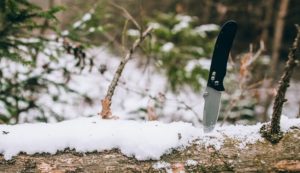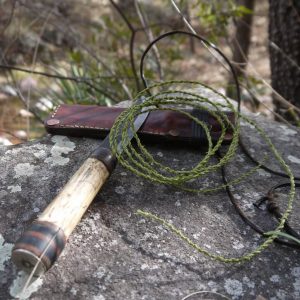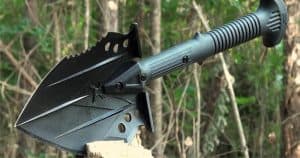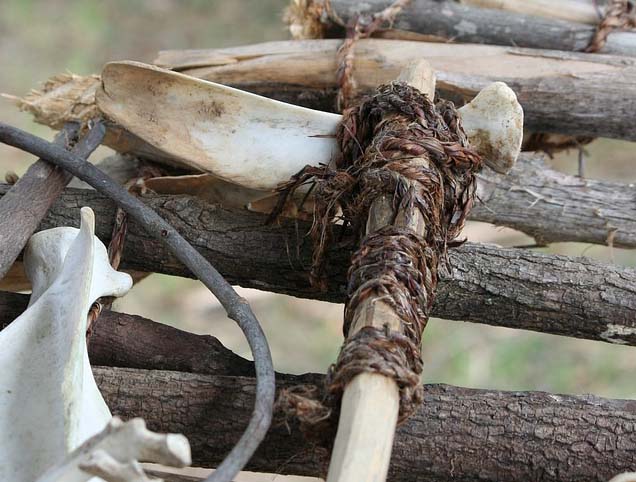The difference between bushcraft and survival is that, with survival, you might be barely alive and struggling. By contrast, bushcraft is about living simply yet comfortably in nature. To achieve this, you will need some bushcraft tools.
Bushcraft Tools List
This list includes bushcraft tools that should be in every beginner’s bushcrafter kit. Remember, there’s nothing wrong with bringing some high-tech items as a backup or to help you stay comfortable.
As you gain skills and experience, you can lighten your load and rely more on primitive and DIY bushcraft tools.
1. Blade

A knife or blade is the ultimate survival tool, and many bushcraft purists would even say that you don’t need anything but a knife. You can use a knife to make many of your own bushcraft tools, baton (splitting) wood, prepare foraged food, and much more.
Since blades are so crucial for bushcraft (as well as survival), a big part of your bushcraft tool budget will probably go towards it.
Note that different blades are required for different tasks and environments – like how all the locals I encountered in the Peruvian jungle had machetes. My usual drop-point blade was practically useless in most situations.
Read:
- Best All-Round Survival Knife
- Best Affordable Survival Knives
- How to Sharpen a Knife in the Bush
- Best Survival Machetes
2. Bushcraft Axe or Hatchet
While you can get by with a knife or saw, you’ll want an axe anytime you plan on spending a longer time in nature. It will come in handy for building semi-permanent or permanent shelters, chopping firewood, shaping logs, and numerous other tasks.
Read:
3. Saw
Saws are an incredibly versatile bushcraft tool. They can be used to clear brush, cut branches for a shelter, saw through bone, cut firewood to size, and much more.
I prefer saws over axes; a saw is lighter and easier to carry. You are less likely to inflict serious damage on nature (or yourself) with a saw than an axe.
Read:
4. Firestarter
There are many primitive ways to start a fire without matches or a lighter, such as making a bow drill or a fire plow. However, the standard bushcraft fire tool is a striking tool, such as flint and steel or Ferro rod and striker.
No matter what bushcraft fire-starting tool you use, it’s crucial to have good tinder. I carry some cotton balls dipped in Vaseline.
Yes, purists would consider this cheating – especially since you can make your own tinder by shaving down sticks or making a “feather stick.” However, it’s nice to have dry tinder as a backup if conditions are bad, especially since starting a fire can mean life or death.
Another option that aligns with the bushcraft mentality is making char cloth for tinder.
Read:
- Expert Tips for Using a Ferro Rod Fire Starter
- Best Tinder for Starting a Fire
- How to Make a Char Cloth
*There’s no shame in bringing a lighter with you. See these best lighters for survival.
5. Cordage

Once you get started with bushcraft, you’ll see how vital cordage is. It’s useful for building shelter frames, setting snares, making a fishing net, hanging a bear bag…
While making your own rope from natural materials is possible, it takes a long time, and the learning curve is pretty high. Paracord 550 is regarded as the best all-purpose rope for survival and bushcraft.
Read:
- Survivalist’s Guide to Rope
- How to Make Rope from Plants
- Most Important Survival Knots
- What Is Paracord?
6. Canteen and Pot
Unless you want intestinal parasites, you’ll need a way to purify water. That usually means boiling water in a pot. And once you’ve purified water, you’ll need a way to transport it, which generally means a durable canteen.
If you have a metal survival canteen, you can boil water right in the canteen. However, I still recommend bringing a bushcraft pot since it is better suited for tasks like cooking meals. You can also use the pot to hold things like foraged berries if you don’t have a basket.
*Note it’s possible to make a pot out of birch bark, but this is one of the higher-level bushcraft skills that takes a lot of practice to master.
Read:
7. Clothing and Footwear
Where backpacking and camping clothing is usually made from high-tech synthetics, bushcraft clothing uses natural fibers. Wool is a favorite, and while I don’t make them myself, I love the wool socks, leggings, and sweater I bought from a local grandma.
Military surplus is also popular for bushcrafting as it’s cheap, and the material is durable, as is leather footwear. When the weather turns very cold, fur-lined clothing is the way to go. If you aren’t a purist, splurge on quality clothing from brands like Fjallraven.
Read:
8. Compass
Learning to navigate without a compass is wise, but the stars aren’t always clear, and the other tactics also don’t always work. So a compass is a great bushcraft tool to have in your kit. Note that several different types of compass are available, so check out our guide to the best compass for survival before buying one.
Get some ranger beads to take your orienteering skills to the next level.
9. Shovel

A shovel is a bushcraft tool that doesn’t get as much attention as tools like knives, but life in nature without a shovel can get uncomfortable quickly.
For me, the primary use of a shovel is to dig a latrine or “cat hole” to bury waste. Not only is this in accordance with the principles of Leave No Trace, but it’s much more hygienic. Burying waste also helps keep animals away.
A shovel is also necessary in winter for building shelters, in bad weather for making drainage ditches around your shelter, and in many other situations.
Read:
10. Carving Tools
Of all the bushcraft tools, I find carving tools the most pleasurable to use. After setting up camp and gathering food, you can use these tools to make a bowl and spoon. Or a pot hanger, whistle, fishing spear, bow and arrow, gorgeous walking stick, smoking pipe…
The more adept you become at carving tools, the better you’ll be able to make more of your own bushcraft tools and gear.
Read:
11. Knife Sharpener
Even the best bushcraft knife will get dull after extended use — and you WILL be using it a lot when practicing bushcraft skills. So, you’ll need to have a knife sharpener with you.
Some bushcrafters prefer to use a natural sharpener, such as a smooth river rock, but it is generally easier to sharpen a knife with a dedicated sharpener.
Read:
12. First aid kit
While this might be considered equipment more than a bushcraft tool, please don’t go bushcrafting without a first aid kit, especially if you are inexperienced!
Many bushcraft tools are large, sharp, and have high learning curves. I’ve heard plenty of terrible stories about people gashing themselves with their hatchet or knives while trying to do camp tasks.
At the very least, you’ll need clean gauze, a tourniquet, an antiseptic balm, and medical tape.
Read:
- Wilderness First Aid Kit Checklist
- How and When to Use a Tourniquet
- Butterfly Bandages for Gaping Wounds
You Can Make Every Tool You Need

Purists will say you don’t need to buy bushcraft tools to live comfortably in nature. With the proper knowledge and skills, you can make everything you need – such as making your own knife blade out of sharpened obsidian, starting a fire with flint you found, or making a trowel out of animal bones.
This is how our ancestors survived and thrived over the years. There are even more recent examples of primitive cultures rejecting modern tools in favor of their traditional tools, such as the Senoi Praaq – a division of the Malay military that used blowpipes to kill enemies instead of the standard-issue machine guns.
By contrast, other bushcrafters have no qualms carrying large kits which contain machine-made tools, including knives, lighters, tarps, and axes.
Is Using Bushcraft Tools “Cheating”?
I’m not a bushcraft purist. While I get more satisfaction from doing things the “old-fashioned” way, I don’t think we need to make everything ourselves. I agree with Gordon Dedman when he said,
“The pursuit of bushcraft brings us closer to the natural world and opens our eyes to see that we are part of the earth and not separate from it.”
Under that definition, any tool that helps us connect with nature can be considered bushcraft. Obviously, people are going to interpret this in their own ways.
For example, most people consider using a lighter “cheating” in bushcraft. Yet those same people don’t consider using a Ferro rod cheating – despite the fact they purchased the Ferro rod.
Likewise, many bushcrafters consider high-tech fabrics like Gore-Tex cheating, but I don’t know any bushcrafters who make all their own clothing on a loom…
Using Modern Tools Is Often MORE Respectful of Nature
I’d like to point out that the bushcraft way is often BAD for nature. Take bushcraft shelters vs. using a tent.
It takes a lot of wood to build a shelter and fire for a night. It also takes a lot of time, so bushcrafters will use their hatchet to hack down live limbs – permanently damaging habitats and even killing trees.
By contrast, I can stay warm and comfortable in my tent and sleeping bag while practicing Leave No Trace. Yes, it did take resources to make the tent and sleeping bag, but they’ve already lasted me through multiple seasons – arguably causing much less damage than building a new shelter every night would inflict.
The bottom line?
There’s no right or wrong way to connect with nature. It doesn’t matter whether you go primitive or include some high-tech items. Bring the bushcraft tools that help you best connect with nature.
Bushcraft Tools vs. Survival Tools
It’s worth noting that there’s a big difference between “survival” and “bushcraft” tools. Survival tools are designed to help you stay alive in a specific environment, just for a short time, such as 72 hours. Thus, survival tools are usually disposable or even single-use.
By contrast, bushcraft tools are designed to help you live comfortably in the wilderness for more extended periods:
Three days is survival. A month is bushcraft. Thus, the tools must be more durable.
A Mylar blanket is not bushcraft gear. But a saw used to get branches for building a debris shelter? Yes.
What bushcraft tools are in your kit? Let us know in the comments.


As you imply “It all depends”.
For me, I prefer a small 10-12 in non-folding saw having had two different folders crap out on me in the past. For cordage 100 ft of 550 and a roll of Spiderwire 65 lb test and some lighter eg 6 or 10 lb monofilament fishing line, and spool of 22ga Stainless wire for snares and traps.
If I were to carry an axe, it would be an Eastwing Long Handle Campers Axe. Never found better.
Nuf’ said for now…
P.S. I’m Karl E
That’s a great list, Diane! Thanks for keeping it up to date.
The author makes several significant points in the closing. Bushcraft Is NOT survival. I would suggest that even 3 months isn’t long enough considering that the History Channel used 100 days to make the 10^6 bucks.
“Leave No Trace” is likely the necessary operational mode until one can find an accepting community to join. After all chopping up the area will leave evidence that a skilled person can spot from cover well over 100 yards away, or a short rifle shot if you prefer.
As to the equipment selected those choices tend to be highly personal but I can find no grievous fault with what is proposed… I probably would have added a 13th group, having to do with harvesting food, and providing protection from the environment.
And maybe even another “My Favorite 5 Widgets that Don’t Fit in Elsewhere” just because we all have them, and those lists could be rather interesting!
Thanks for the comment. As you mention, tool choice is highly personal — I had a hard time breaking it down to “essentials”, especially since an experience bushcrafter could make so many tools — like harvesting baskets — by using other tools. And I’d also love to see those 5 Favorite Widget lists 😀